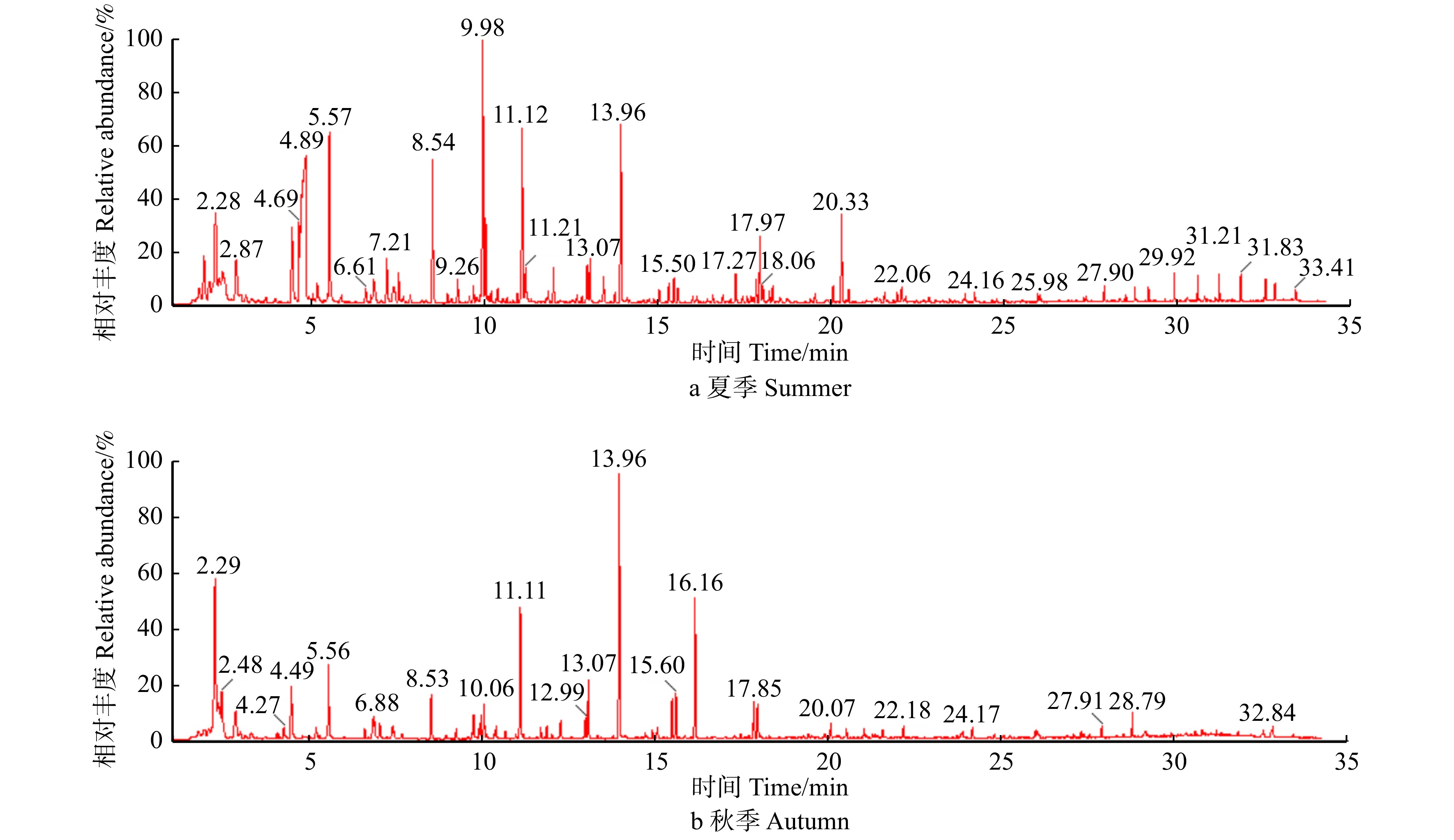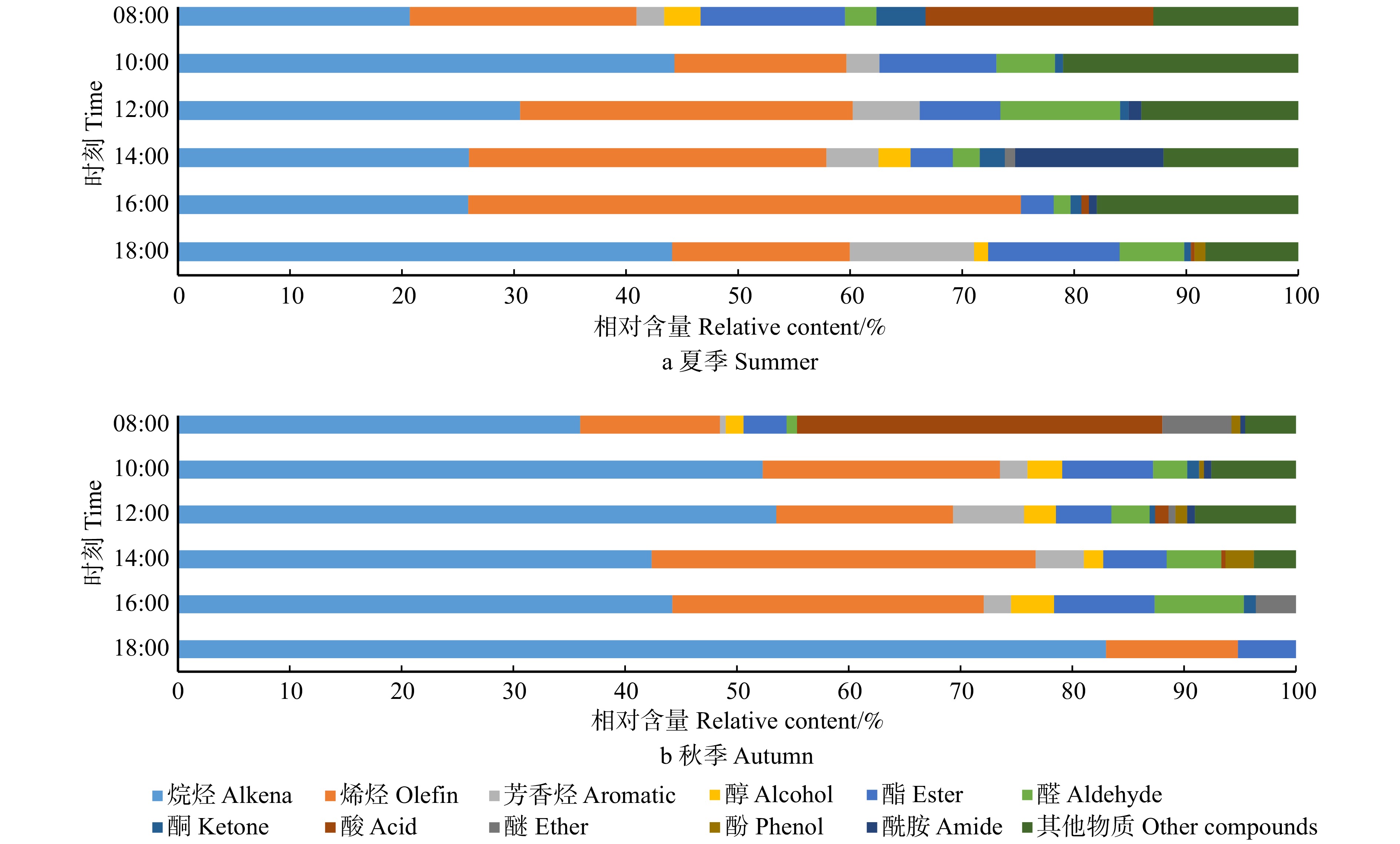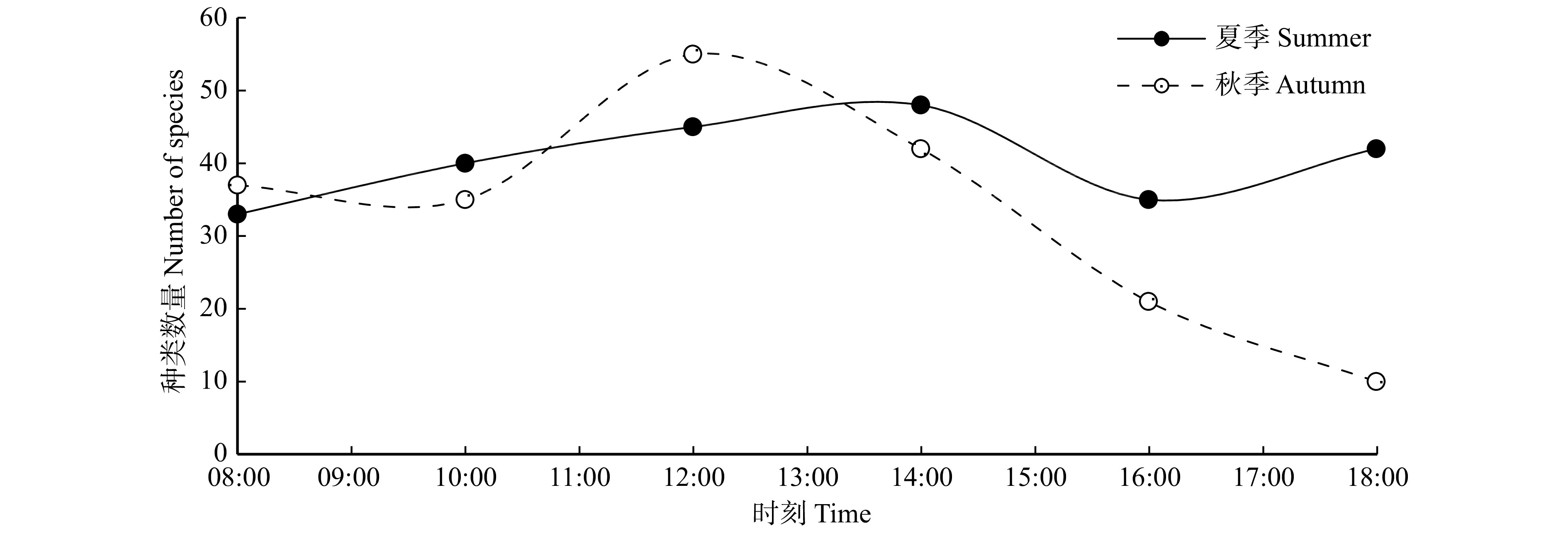Releasing variation and bacteriostatic effects of botanic volatile organic compounds from Pinus tabuliformis
-
摘要:目的 植物挥发性有机物(BVOCs)中的一些成分具有净化空气、改善身心健康的生态功能。通过研究夏秋季节油松叶片BVOCs的成分、动态变化及其对于空气微生物的抑制作用,揭示油松叶片释放BVOCs组分与规律,探索其抑菌特性,为森林康养型植物的选择及应用提供理论依据。方法 利用动态顶空吸附采集法与热脱附−气相色谱−质谱(TDS-GC-MS)联用技术,进行油松叶片BVOCs的采集与分析。通过城市微生物采集点与油松样地空气微生物含量测定的对照试验计算油松叶片BVOCs的抑菌率。结果 (1)油松叶片释放的BVOCs共测定出11类173种化合物,其中,夏季共测定出11类113种化合物,秋季共测定出11类103种化合物。主要组成成分为烷烃与烯烃,夏季含量最高可达70%以上,秋季最高可达90%以上。夏季较秋季油松叶片释放的BVOCs组成成分更丰富且总量高但夏季油松叶片BVOCs释放峰值要滞后于秋季。(2)在环境因子中,油松BVOCs释放量与大气温度呈不显著正相关,与大气湿度呈不显著负相关。(3)油松叶片BVOCs抑菌物质释放量呈现出“一峰一谷”的日变化趋势,夏、秋季抑菌物质释放峰值分别为14:00与12:00,且夏季较秋季抑菌物质释放总量高。油松对空气微生物的抑制作用具有明显的日变化规律,其中以对细菌的抑制作用最显著,且抑菌率表现为早上 > 中午 > 晚上。(4)综合考虑油松BVOCs对人体有益及有害影响,夏季在16:00,油松叶片BVOCs中有益于人体健康的成分相对含量达到一天中的最高值,有害物质相对含量为一天中的最低值;在秋季,14:00至16:00油松叶片BVOCs中有益于人体健康的成分相对含量上升,有害物质相对含量下降,且在16:00左右抑菌物质相对含量达到峰值,有害物质相对含量接近于零。结论 在一天不同时间和一年不同季节(夏季和秋季)油松叶片释放BVOCs的组成及相对含量存在较大差异。油松叶片BVOCs对空气中细菌有明显抑制作用,具有明显的改善空气质量作用。夏秋季节14:00至16:00左右林内对人体有益的油松植物挥发物质较多,对人体产生不利影响的挥发物质较少。研究结果为进一步揭示油松释放BVOCs调节人体健康的生理响应机制提供理论依据。Abstract:Objective Some components of botanic volatile organic compounds (BVOCs) have the ecological functions of bacteriostasis, disease elimination and health care. In this paper, the composition and dynamic of BVOCs in leaves of Pinus tabuliformis in summer and autumn were studied, as well as their inhibitory effects on air microorganisms, which provided scientific basis for the selection and application of plants for health rehabilitation and recreation in forest (HRRF).Method The BVOCs in P. tabuliformis leaves were collected and analyzed by dynamic headspace adsorption method and thermal desorption system gas chromatography/mass spectrometer (TDS-GC-MS) technique. The bacteriostatic rate of BVOCs in P. tabuliformis leaves was calculated through the control experiment of air microbial content determination in urban microbial collection point and P. tabuliformis forest sample plots.Result (1) A total of 173 compounds of 11 classes were detected in the BVOCs released from P. tabuliformis leaves. There were 113 compounds of 11 classes detected in summer and 103 compounds of 11 classes detected in autumn. The main components were alkanes and olefins, with the maximum content over 70% in summer and over 90% in autumn. The BVOCs released from P. tabuliformis leaves in summer were more abundant than that in autumn. Meanwhile, the total amount of BVOCs in summer was higher than that in autumn. However, the peak of release in summer was later than in autumn. (2) Among the environmental factors, there was no significantly positive correlation between atmospheric temperature and the release of BVOCs from P. tabuliformis, while there was no significant negative correlation between atmospheric humidity and the release of BVOCs from P. tabuliformis. (3) The release of BVOCs from leaves of P. tabuliformis showed a diurnal trend of “one peak and one valley” with peaks of BVOCs released in summer and autumn at 14:00 and 12:00, respectively. More antibacterial substances were released in summer than in autumn.The inhibitory effect of P. tabuliformis on air microorganisms had obvious diurnal variation, and the most significant inhibitory effect was on bacteria, and the inhibition rate was morning > noon > evening. (4) Considering the beneficial and harmful effects of BVOCs on the human body, the relative content of healthy ingredients in BVOCs from P. tabuliformis leaves reached the highest value at 16:00 in summer, while the relative content of harmful compounds reached the lowest value. In autumn, from 14:00 to 16:00, the relative content of components beneficial to human health in the BVOCs of P. tabuliformis leaves increased while the relative content of harmful compounds decreased. Moreover, the relative content of antibacterial compounds reached the peak at about 16:00, and the relative content of harmful compounds was close to zero.Conclusion There are significant variations in the composition and relative content of BVOCs released from leaves of P. tabuliformis at different time of day and in different seasons of the year (summer and autumn). The BVOCs from P. tabuliformis leaves had obvious inhibitory effect on inhibiting bacteria in the air and improving air quality. From 14:00 to 16:00 in summer and autumn, there are more beneficial compounds and fewer harmful compounds in P. tabuliformis forest. The results provide theoretical basis for further revealing the physiological response mechanism of BVOCs released by P. tabuliformis to regulate human health.
-
森林火灾是一种危害性极大的自然灾害,及时并准确检测森林火灾是森林防火的重要内容之一。森林烟火探测方法一般采用地面巡护、瞭望台监测、地面雷达、卫星遥感和分布式传感器网络技术[1]。这些技术多是通过火灾探测器中的参量分析来判断森林中是否发生了火灾,但是复杂的森林环境容易干扰其信号,降低火灾检测的准确率。随着计算机技术的发展,利用图像及视频分析技术检测森林烟火的方法越来越多。视频火灾检测技术具有更广的空间覆盖,且森林火灾检测准确率更高。现有的利用图像及视频分析技术检测森林烟火算法多是针对可见光视频。基于可见光视频的森林烟火检测算法一般是检测火焰或烟的颜色特征、纹理特征和动态特征。武桂林等[2]采用最小均方算法对视频中基于慢运动物体检测、烟雾颜色区域检测、上升烟区检测、阴影检测与去除等4个子算法进行加权得到决策值以判断是否发生火灾;Jia等[3]通过森林火灾中的颜色和运动特征得到显著特征图像,再根据运动能量特征与显著特征图像估计可疑烟区;Ko等[4]利用森林火灾中烟的时空差异特征与随机森林相结合检测森林火灾;Krstini等[5]分析森林火灾中有烟区域和无烟区域在不同颜色空间的直方图特征,实现对森林火灾中烟的实时检测;Yuan[6]提取森林火灾中烟的纹理特征,将图像LBP和LBPV的直方图序列与神经网络分类器结合实现视频中烟的检测;邵婧等[7]提出一种基于动态纹理特征分析的火灾检测算法,他们对视频图像建立线性动力系统模型,分析其动态纹理特征,最后采用Adaboost分类器判断是否发生火灾。上述基于可见光视频的森林烟火检测算法虽然利用多种火灾的颜色、纹理及动态特征,但是很难适应森林中复杂的环境变化。现阶段森林烟火检测还有针对红外视频的算法,张红民等[8]提出了一种基于邻域对比的目标提取算法检测红外视频中的森林火灾。因为在红外视频中森林火点为高温区域,所以基于红外视频检测森林火灾的算法一般采用传感器网络处理得到的火灾信号[9],但是红外视频中与森林火点具有相似特征的影响因素比较多,尤其在白天,经过阳光照射的石头、工作设备等都属于干扰因素,容易影响算法的准确度,因此森林火灾的误检率也比较高。由于森林烟火在可见光视频和红外视频中具有各自不同的特点,将两种视频中的数据进行融合可以保留森林火灾在两种视频中的特征,更有利于森林烟火检测,但是国内外在森林火灾的可见光视频和红外视频融合方面的研究非常少,王进成等[10]采用编号标记、编号生存期等一系列标记机制跟踪识别火焰目标,并采用基于图像轮廓的算法,结合硬件DSP与ARM双系统组合检测火灾。上述的基于红外和可见光视频融合的火灾检测更侧重的是硬件方面的设计,并且实验环境比较简单,完全不同于森林火灾的复杂环境情况,因此本文基于红外视频和可见光视频的森林烟火检测方法,提出了一种基于分数阶微分的红外和可见光融合算法。
本文提出一种新的基于分数阶微分融合(Fractional-Calculus Based Fusion Algorithm, 简称FCBF算法)红外和可见光视频的森林烟火检测算法可对林区烟火进行实时准确的检测。首先,基于分数阶微分理论将红外视频和可见光视频融合;然后,再对融合后的视频采用背景减法判断是否出现异常情况,如若判断发生异常,则提取异常帧图像进行阈值分割,同时也提取背景帧与异常帧的差分图像,再对差分图像进行阈值分割;最后,对分割后的异常帧图像与差分图像进行去噪处理,得到森林烟火区域并在融合视频中将其用黑色的方框框出。实验结果表明,本文算法能够提高森林中烟火检测的准确率,从而减少误检和漏检的情况。
1. 算法介绍
分数阶微分是数学分析领域的一个重要分支,它是整数阶微分运算的推广,但由于微分的分数阶概念不宜理解,因此没有得到广泛应用。数字图像处理中经典的基于一阶微分的Sobel算子、Prewitt算子、Roberts算子和基于二阶微分的Laplace算子等都是由数学中的模型衍生而来,因此将非整数步长的分数阶微分应用到数字图像处理中具有广阔的发展前景。
目前,分数阶微分在数字图像处理中主要应用于去噪、图像增强以及边缘检测。Zhang等[11]分析了不同阶次的微分对图像中高斯噪声的去除效果,发现分数阶的微分去噪效果优于整数阶微分,并且图像结构和纹理的保留情况也比整数阶微分效果好;Pu等[12]利用分数阶微分提出了一种纹理图像去噪模型,因为与整数阶微分相比,分数阶微分能非线性增强图像中复杂的纹理细节信息,能更好地保留图像中的边缘和纹理信息;Yang等[13]先用分数阶微分增强遥感图像以提取图像中的道路,其实验结果表明,较于传统的图像增强方法,基于分数阶微分的图像增强方法对于检测狭窄、模糊的道路效果更好;Chi等[14]通过分数阶微分提取掌纹,并与采用经典的Sobel算子、Prewitt算子和Laplace算子的实验结果进行比较,其峰值信噪比明显高于经典的整数阶算子;Ghamisi等[15]提出了分数阶达尔文粒子群优化算法,图像分割结果优于经典的图像阈值分割结果。
本文创新性地提出了一种基于分数阶微分融合算法(FCBF算法),该算法融合红外和可见光视频图像进行森林烟火检测。FCBF算法主要利用分数阶微积分思想代替图像的梯度信息,然后通过比较同一位置处红外和可见光图像中的分数阶微分值确定最终融合图像的像素值。实验结果表明,该融合算法在降低算法复杂度的同时增强像素的邻域信息从而得到更好的边缘信息。
本文提出的森林烟火检测算法流程如图 1所示。首先,采用基于分数阶微分理论融合红外视频和可见光视频;然后,对融合后的视频采用背景减法判断是否出现异常情况,即森林中是否发生火灾;如果判断融合视频中出现异常情况,则提取异常帧图像进行R-C阈值分割,同时也提取背景帧图像与异常帧图像进行差分,再对差分图像进行矩不变法阈值分割;最后,对分割后的异常帧图像与差分图像取交集区域,并采用自适应局部平滑法去除噪声,得到森林烟火区域,在融合视频中将检测到的森林烟火区域用黑色方框框出。
1.1 本文算法主要步骤
Step 1:基于FCBF算法融合红外和可见光图像,见图 2。
Step 2:背景法判断是否出现异常,对序列图像作减法运算。
设视频的序列图像fi(x, y), i=0, 1, 2, …,N,(x, y)为图像中各个像素的坐标,N为连续序列图像的帧数目。两幅图像的差值计算公式为:
Δfi(x,y)=fi(x,y)−f0(x,y)={0,Δfi(x,y)<T1,Δfi(x,y)≥T (1) 式中:Δfi(x, y)为两幅图像的差值,fi(x, y)为当前图像,f0(x, y)为背景图像,T为阈值(T为经验值)。
用两幅图像的差值与阈值T的比较判断视频中是否出现异常:如果出现异常,进行Step 3~7;如未出现异常,则摄像头继续进行检测。
Step 3:背景图像与异常帧进行差分,然后采用矩不变法对差分图像阈值分割。
Step 4:异常帧图像则是可能存在森林火灾的图像,因此对异常帧图像要进行可疑火点区域判断,对异常帧图像进行R-C法阈值分割。
Step 5:异常帧的阈值分割图像与差分的阈值分割图像取交集区域,见图 3。
Step 6:采用自适应局部平滑方法去除分割图像的噪声,得到可疑火点区域图像,见图 4a。
Step 7:可疑火点区域图像中的最大连通区域即为森林火灾区域,在融合图像中用黑色线条框出森林火灾区域,见图 4b。
1.2 本文算法创新点
本文是基于红外和可见光波段的融合视频检测森林火点,采用基于小波变换和Contourlet变换的融合算法需要图像分解、融合再重构,其过程比较繁琐,视频融合算法复杂度高,实时性差,不适用于实际的林火监测;然而基于区域能量的融合算法虽然可以反映红外和可见光图像中明显的亮度突变,但又忽略了微小的细节变化,使得融合图像比较模糊,出现清晰度下降和信息熵减少等情况;基于窗口方差的融合算法使得融合图像的对比度下降、目标指示能力减弱,并不能充分提取红外图像与可见光图像的互补信息。采用基于HSI变换的融合算法虽然提高了融合图像的空间分辨率,但使得融合后的图像色调饱和度值产生了扭曲,融合图像中出现色块,严重影响融合图像的效果。
为解决上述算法中出现的问题,既能实现红外和可见光视频的实时融合,又可以尽可能保留红外和可见光视频中森林火点的特征,本文将分数阶微分理论引入红外和可见光视频融合技术中,并创新性地提出一种基于分数阶微分融合算子的森林烟火检测算法(FCBF算法),该算法对红外视频及可见光视频图像的分数阶微分值进行加权得到融合图像,并分析该融合图像检测森林烟火区域。
由于分数阶微积分的计算过程复杂,为了降低算法的复杂度, 我们利用图 5所示分数阶微分算子计算图像的分数阶微分值。
图 5中的像素模板结构考虑到了当前像素在两个坐标轴正负向以及斜45°邻域方向的像素信息。FCBF算法采用图 5中的分数阶微分算子同时扫描待融合的红外和可见光图像,计算图像中同一位置处红外和可见光图像的分数阶微分值,分数阶微分值D的计算公式为:
D={18−24v+16v2|2v2−v02v2−v02v2−v0−2v−2v−2v02v2−v−2v8−2v2v2−v0−2v−2v−2v02v2−v02v2−v02v2−v|−1}I (2) 式中:D为分数阶微分值,v为微分阶数(经验值为0.1),I为待融合的红外和可见光图像中模板对应的像素点的像素值。
如将同一位置处红外图像和可见光图像的分数阶微分值D作为衡量图像信息的重要程度,并利用分数阶微分值D得到融合权重系数wA和wB。计算公式为:
wA=DADA+DB (3) wB=1−wA (4) 式中:A和B分别代表红外图像和可见光图像,DA和DB表示红外和可见光图像的分数阶微分值。
融合图像F的像素值可由下式得出:
fF(i,j)=wAfA(i,j)+wBfB(i,j) (5) 式中:fA(i, j)、fB(i, j)和fF(i, j)分别表示红外、可见光和融合图像中像素点(i, j)的像素值,wA和wB表示红外和可见光图像在融合图像中所占的权重。
2. 结果与分析
本文实验数据为北京门头沟林区红外视频和可见光视频,实验中采用了2m×2m的加热板(65~90℃)模拟红外视频中的森林火点,同时采用烟雾弹(饼)模拟可见光视频中的森林火灾中的烟。图 6~9是门头沟4个不同火点的红外及可见光原始视频帧图像、融合后的图像及森林烟火的检测结果。为了阐明本文提出的FCBF算法的有效性,作者比较了FCBF算法与基于区域能量融合规则[16]、基于窗口方差融合规则[17]和基于HSI变换融合算法的图像融合效果、林火检测准确率和森林烟火检测时间的误差度。
图 6~9中:a为可见光图像;b为红外图像;c和d为基于区域能量算法融合图像及其检测结果;e和f为基于窗口方差算法融合图像及其检测结果;g和h为基于HSI变换算法融合图像及其检测结果;i和j为基于FCBF算法融合图像及其检测结果。图 6~9中如果检测到森林烟火发生,则将该区域用黑色方框标记。从图 6~9中可以看出,基于分数阶微分融合的图像细节信息保留情况优于其他3种方法,FCBF算法的融合图像更为清晰,并且森林火灾监测更为准确。例如,在图 7e、f中,基于窗口方差融合算法没有检测到森林烟火区域;在图 8c、d中,基于区域能量融合算法出现了误检的情况;在图 9c、d中,基于区域能量融合算法检测出的森林烟火区域不精确;而图 6~9的g、h中,基于HSI变换融合算法均无法检测出森林火灾区域,其原因可能是该算法用红外图像信息代替了可见光图像中的I通道信息,而森林火灾的烟在I通道中特征比较明显,因此降低了森林火灾区域检测的准确率且使得融合图像中出现大片失真的蓝色区域。
本文比较了FCBF算法、基于区域能量融合算法、基于窗口方差融合算法和基于HSI变换融合算法的图像融合效果、对森林烟火检测的准确率和森林火灾发生初期的时间误差度。文中采用空间频率和平均梯度作为图像融合效果的评判测度。4种测度定义如下。
1) 空间频率S
S=√R2+C2 (6) 式中:R为图像的行频率,C为图像的列频率。
图像的空间频率能够反映图像空间域的整体活跃程度,因此图像的空间频率越大,图像的效果越好。
R=√1MNM∑i=1N∑j=2[F(i,j)−F(i,j−1)]2 (7) 式中:M为窗口的长度,N为窗口的宽度,F(i, j)为图像中像素值。
C=√1MNN∑j=1M∑i=2[F(i,j)−F(i−1,j)]2 (8) 2) 平均梯度AG
AG=1(M−1)(N−1)M−1∑i=1N−1∑j=1[((F(i,j)−F(i+1,j))2+(F(i,j)−F(i,j+1))2)/2]12 (9) 平均梯度指的是敏感反映图像对微小细节反差表达的能力,同时也可以反映图像的清晰度,因此图像的平均梯度越大,图像就越清晰。
3) 森林烟火检测的准确率P
P=TPTP+FP×100% (10) 式中:TP表示准确检测到的森林烟火的帧数,FP为漏检和误检的帧数。
森林烟火检测的准确率P展现了算法的有效性和鲁棒性。
4) 森林火灾的时间误差度T
T=|DT−PT|PT×100% (11) 式中:DT为检测到森林火灾发生的时间,PT为实际森林火灾发生的时间。
该时间测度反映了算法对森林火灾发生初期的时间灵敏程度,因此T值越小,算法就越有效。
从表 1可以看出:本文提出的FCBF算法的空间频率和平均梯度均高于其他3种算法,因此实验结果表明FCBF算法的图像融合效果最好;FCBF算法在森林烟火检测准确率和时间误差度方面明显优于其他3种算法,基于HSI变换的图像融合算法准确率最低且时间误差度最高。通过表 1数据的综合评判可知,FCBF算法的图像融合效果最好,并且森林烟火检测的准确率和时间灵敏程度最好,所以本文提出的FCBF算法很有效。
表 1 FCBF算法与其他3种算法性能比较Table 1. Comparison of FCBF algorithm and other algorithms算法
Algorithm空间频率
Spatial frequency(S)平均梯度
Average gradient(AG)准确率
Detection accuracy rate(P)/%时间误差度
Detection time rate(T)/%HSI变换融合算法HSI fusion algorithm 16.3270 7.8280 1.26 56.12 区域能量融合算法Regional energy fusion algorithm 28.3191 12.3122 86.20 38.57 窗口方差融合算法Regional variance fusion algorithm 32.5767 16.1555 87.13 21.14 FCBF算法FCBF algorithm 35.9066 19.6399 91.85 2.03 3. 结论
本文主要研究红外和可见光视频融合算法及基于融合图像分析的森林烟火检测技术,提出了一种新的基于分数阶微分融合红外和可见光视频的森林火灾检测算法(FCBF算法)。实验结果表明,本文提出的FCBF算法中的红外和可见光的融合图像比基于区域能量融合图像、基于窗口方差融合图像和基于HSI变换融合图像更为清晰丰富。同时,本文对FCBF算法、基于区域能量融合算法、基于窗口方差融合算法和基于HSI变换融合算法的图像融合效果、森林烟火检测的准确率和森林火灾发生初期检测的时间误差度进行了定量比较。FCBF算法在空间频率和平均梯度这两个反映图像融合效果的评价准则方面均优于其他3种算法;FCBF算法比基于区域能量融合算法错检和漏检情况少,对于森林烟火检测的准确率和检测的时间误差度优于其他3种算法,并且明显优于基于HSI变换融合算法。本文算法可以在比较复杂的森林环境中非常准确地检测到火灾初期的烟和火,并且能够精准显示出森林烟火的发生地点以及火灾的变化过程,因此可以及时预警森林火灾的发生,为防止森林火灾的蔓延提供了有利的途径。
-
表 1 样地基本信息
Table 1 Basic information of sample plots
样地类型
Type of sample plot纬度
Latitude经度
Longitude海拔
Altitude/m面积/hm2
Area/ha林龄/a
Stand age/year平均胸径
Mean DBH/cm油松林样地
Pinus tabuliformis forest sample plot39°58′13″N 116°11′40″E 201 16.9 57 18.6 城市微生物采集点
Urban microbial collection point40°00′23″N 116°20′23″E 50 − 50 23.5 表 2 夏秋季节油松BVOCs释放量日变化与环境因子的相关性
Table 2 Correlation between emission diurnal variations of BVOCs from Pinus tabuliformis and environmental factors in summer and autumn
环境因子类型
Type of environmental factor季节
Season相关系数
Correlation coefficient显著水平
Significant level温度
Temperature夏季
Summer0.254 0.628 秋季
Autumn0.799 0.056 湿度
Humidity夏季
Summer−0.216 0.682 秋季
Autumn−0.459 0.359 表 3 夏秋季节不同时刻油松BVOCs对空气微生物的抑制作用日变化
Table 3 Diurnal variations of inhibition effect of Pinus tabuliformis BVOCs on airborne microorganisms in summer and autumn
季节
Season细菌抑菌率 Bacteriostatic rate for bacteria/% 真菌抑菌率 Bacteriostatic rate for fungus/% 08:00 12:00 18:00 08:00 12:00 18:00 夏季
Summer55.24 47.78 36.36 10.00 0.00 0.00 秋季
Autumn79.17 38.10 66.67 20.19 0.00 0.00 -
[1] Ronald B. Secondary metabolites play primary roles in human affairs[J]. Perspectives in Biology and Medicine, 1997, 40: 197−221. doi: 10.1353/pbm.1997.0002
[2] Kim J C, Kim K J, Kim D S, et al. Seasonal variations of monoterpene emissions from coniferous trees of different ages in Korea[J]. Chemosphere, 2005, 59(11): 1685−1696. doi: 10.1016/j.chemosphere.2004.10.048
[3] 陈欢, 章家恩. 植物精气研究进展[J]. 生态科学, 2007, 26(3): 281−287. doi: 10.3969/j.issn.1008-8873.2007.03.016 Chen H, Zhang J E. Advances in the study of phytoncidere[J]. Ecological Science, 2007, 26(3): 281−287. doi: 10.3969/j.issn.1008-8873.2007.03.016
[4] 李洪远, 王芳, 熊善高, 等. 植物挥发性有机物的作用与释放影响因素研究进展[J]. 安全与环境学报, 2015, 15(2): 292−296. doi: 10.13637/j.issn.1009-6094.2015.02.060 Li H Y, Wang F, Xiong S G, et al. Research review on the role and the influential factors of the biogenic volatile organic compounds[J]. Journal of Safety and Environment, 2015, 15(2): 292−296. doi: 10.13637/j.issn.1009-6094.2015.02.060
[5] 贾梅, 金荷仙, 王声菲. 园林植物挥发物及其在康复景观中对人体健康影响的研究进展[J]. 中国园林, 2016, 32(12): 26−31. doi: 10.3969/j.issn.1000-6664.2016.12.006 Jia M, Jin H X, Wang S F. On the progress of research of landscape plant volatile compounds and their influence on human health in rehabilitation landscape[J]. Chinese Landscape Architecture, 2016, 32(12): 26−31. doi: 10.3969/j.issn.1000-6664.2016.12.006
[6] 文野, 潘洋刘, 晏琪, 等. 森林挥发物保健功能研究进展[J]. 世界林业研究, 2017, 30(6): 19−23. Wen Y, Pan Y L, Yan Q, et al. Research development in healthcare function of BVOCs[J]. World Forestry Research, 2017, 30(6): 19−23.
[7] 谢小洋, 冯永忠, 王得祥, 等. 我国西北地区夏季油松挥发物成分日变化及其影响因子研究[J]. 西北农林科技大学学报(自然科学版), 2016, 44(8): 111−118. Xie X Y, Feng Y Z, Wang D X, et al. Diurnal variation and influencing factors of volatile organic compounds from Pinus tabuliformis in summer in northwest area of China[J]. Journal of Northwest A&F University (Natural Science Edition), 2016, 44(8): 111−118.
[8] 邱新彩, 彭道黎, 李伟丽, 等. 北京延庆区不同林龄油松人工林土壤理化性质[J]. 应用与环境生物学报, 2018, 24(2): 221−229. doi: 10.19675/j.cnki.1006-687x.2017.05012 Qiu X C, Peng D L, Li W L, et al. Soil physicochemical properties of Pinus tabuliformis plantations of different ages in Yanqing, Beijing[J]. Chinese Journal of Applied and Environmental Biology, 2018, 24(2): 221−229. doi: 10.19675/j.cnki.1006-687x.2017.05012
[9] 段劼, 马履一, 贾黎明, 等. 北京地区油松人工林树冠竞争因子的测算与分析[J]. 东北林业大学学报, 2012, 40(3): 14−18. doi: 10.3969/j.issn.1000-5382.2012.03.005 Duan J, Ma L Y, Jia L M, et al. Analysis and calculation of crown competition factor in Pinus tabulaefomis plantations in Beijing[J]. Journal of Northeast Forestry University, 2012, 40(3): 14−18. doi: 10.3969/j.issn.1000-5382.2012.03.005
[10] 任真. 油松挥发物及其功能研究进展[J]. 中国园艺文摘, 2014, 30(6): 96−97. doi: 10.3969/j.issn.1672-0873.2014.06.044 Ren Z. Perspective of VOCs emission and its functions in Pinus tabuliformis[J]. Chinese Horticelture Abstracts, 2014, 30(6): 96−97. doi: 10.3969/j.issn.1672-0873.2014.06.044
[11] 郭秀艳. 臭柏、油松精油的提取与抑菌活性[D]. 呼和浩特: 内蒙古农业大学, 2009. Guo X Y. The extraction and antibacterial affect of Sabina vulgaris Ant. and Pinus tabuliformis Carr.[D]. Hohhot: Inner Mongolia Agricultural University, 2009.
[12] Peñuelas J, Llusià J. Plant VOC emissions: making use of the unavoidable[J]. Trends in Ecology and Evolution, 2004, 19(8): 402−404. doi: 10.1016/j.tree.2004.06.002
[13] Dixon R A. Natural products and plant disease resistance[J]. Nature, 2001, 411: 843−847. doi: 10.1038/35081178
[14] 吴传万, 杜小凤, 徐建明, 等. 植物源抑菌活性成分研究新进展[J]. 西北农业学报, 2004, 13(3): 81−88. doi: 10.3969/j.issn.1004-1389.2004.03.022 Wu C W, Du X F, Xu J M, et al. Research advances in natural antibacterial constituents from plant origin[J]. Acta Agriculturae Boreali-occidentalis Sinica, 2004, 13(3): 81−88. doi: 10.3969/j.issn.1004-1389.2004.03.022
[15] 姚雷, 张少艾. 芳香植物[M]. 上海: 上海教育出版社, 2002. Yao L, Zhang S A. Aromatic plant[M]. Shanghai: Shanghai Educational Publishing House, 2002.
[16] 刘雪, 何英兰, 胡月英, 等. 3-蒈烯对铜绿假单胞菌的抑菌活性及机理初探[J]. 热带作物学报, 2019, 40(3): 601−608. doi: 10.3969/j.issn.1000-2561.2019.03.027 Liu X, He Y L, Hu Y Y, et al. Primary antibacterial activity and mechanism of 3-carene against the Pseudomonas aeruginosa[J]. Chinese Journal of Tropical Crops, 2019, 40(3): 601−608. doi: 10.3969/j.issn.1000-2561.2019.03.027
[17] Labib R M, Youssef F S, Ashour M L, et al. Chemical composition of Pinus roxburghii bark volatile oil and validation of its anti-inflammatory activity using molecular modelling and bleomycin-induced inflammation in albino mice[J]. Molecules, 2017, 22(9): 1384. doi: 10.3390/molecules22091384
[18] 舒慧珍, 唐志凌, 韩薇, 等. 石竹烯对热杀索丝菌的抑菌机理[J]. 食品科学, 2020, 41(15): 31−38. doi: 10.7506/spkx1002-6630-20190725-334 Shu H Z, Tang Z L, Han W, et al. Antibacterial activity and mechanism of caryophyllene against Brochothrix thermosphacta[J]. Food Science, 2020, 41(15): 31−38. doi: 10.7506/spkx1002-6630-20190725-334
[19] 凌玮玮. 牡荆化学成分及其抑菌活性研究[D]. 合肥: 安徽农业大学, 2010. Ling W W. Constituents and antibacterial activities of Vitex negundo Linn. var. cannabifolia[D]. Hefei: Anhui Agricultural University, 2010.
[20] 李娟. 侧柏和油松挥发物动态变化规律研究[D]. 北京: 中国林业科学研究院, 2009. Li J. The VOCs emittion of two tree species of Platycladus orientalis and Pinus tabuliformis in urban environment[D]. Beijing: Chinese Academy of Forestry, 2009.
[21] 戴向荣, 蒋立科, 罗曼. 肉桂醛抑制黄曲霉机理初探[J]. 食品科学, 2008, 29(1): 36−40. doi: 10.3321/j.issn:1002-6630.2008.01.002 Dai X R, Jiang L K, Luo M. Preliminary study of cinnamaldehyde inhibition on aspergillus flavous[J]. Food Science, 2008, 29(1): 36−40. doi: 10.3321/j.issn:1002-6630.2008.01.002
[22] 林富平, 周帅, 马楠, 等. 4个桂花品种叶片挥发物成分及其对空气微生物的影响[J]. 浙江农林大学学报, 2013, 30(1): 15−21. doi: 10.11833/j.issn.2095-0756.2013.01.003 Lin F P, Zhou S, Ma N, et al. Volatile organic compounds in leaves of Osmanthus fragrans and their effect on airborne microorganisms[J]. Journal of Zhejiang A&F University, 2013, 30(1): 15−21. doi: 10.11833/j.issn.2095-0756.2013.01.003
[23] Nguyen V C, Tadao K, Hiromichi K, et al. Antimicrobial activity of Kumazasa (Sasa albo-marginata)[J]. Agricultural and Biological Chemistry, 1982, 46(4): 971−978.
[24] 张薇, 程政红, 刘云国, 等. 植物挥发性物质成分分析及抑菌作用研究[J]. 生态环境, 2007, 16(5): 1455−1459. Zhang W, Cheng Z H, Liu Y G, et al. The bactericidal and aromatic substance of volatile gas of the plant[J]. Ecology and Environment, 2007, 16(5): 1455−1459.
[25] Joung D, Song C, Ikei H, et al. Physiological and psychological effects of olfactory stimulation with D-limo-nene[J]. Advances in Horticultural Science, 2015, 28(2): 90−94.
[26] 周世宁, 陈维田, Burnett J, 等. 空调室内环境的气传微生物[J]. 环境科学学报, 1997, 17(4): 498−501. Zhou S N, Chen W T, Burnett J, et al. A study of microorganisms in air-conditioned indoor environment[J]. Acta Scientiae Circumstantiae, 1997, 17(4): 498−501.
[27] 王成, 郄光发, 董建华, 等. 侧柏、香樟枝叶挥发物对人体生理的影响[J]. 城市环境与城市生态, 2010, 23(3): 30−37. Wang C, Qie G F, Dong J H, et al. Effect of VOCs from branch and leaf of Platycladus orientalis and Cinnamomum camphora on human physiology[J]. Urban Environment & Urban Ecology, 2010, 23(3): 30−37.
[28] 王小婧. 北京市主要风景游憩林两种保健资源及其作用初探[D]. 北京: 北京林业大学, 2008. Wang X J. Primary study on the two healthcare resources and their function of the main scenic & recreational forests in Beijing[D]. Beijing: Beijing Forestry University, 2008.
[29] 高岩. 北京市绿化树木挥发性有机物释放动态及其对人体健康的影响[D]. 北京: 北京林业大学, 2005. Gao Y. Releasing variation and effects on human health of volatile organic compounds from landscape trees in Beijing[D]. Beijing: Beijing Forestry University, 2005.
[30] 郭高轩, 刘久荣, 许亮, 等. 近300年来北京地区降水的变化特征[J]. 水资源与水工程学报, 2011, 22(1): 90−93. Guo G X, Liu J R, Xu L, et al. Change characteristics of precipitation in Beijing region from 1724 to 2009[J]. Journal of Water Resources and Water Engineering, 2011, 22(1): 90−93.
[31] 陆蓓蓓, 黄发源, 单晓梅, 等. 合肥市水源与饮用水中挥发性卤代烃健康风险评价[J]. 中国预防医学杂志, 2013, 14(4): 260−264. Lu B B, Huang F Y, Shan X M, et al. Health risk assessment of volatile chlorinated hydrocarbons in drinking water in Hefei[J]. Chinese Preventive Medicine, 2013, 14(4): 260−264.
[32] 李雷, 李红, 王学中, 等. 广州市中心城区环境空气中挥发性有机物的污染特征与健康风险评价[J]. 环境科学, 2013, 34(12): 4558−4564. Li L, Li H, Wang X Z, et al. Pollution characteristics and health risk assessment of atmospheric VOCs in the downtown area of Guangzhou, China[J]. Environmental Science, 2013, 34(12): 4558−4564.
[33] 郑义. 黑皮油松、白桦挥发物及其抑菌作用研究[D]. 哈尔滨: 东北林业大学, 2008. Zheng Y. Antibitic functions and volatile organic compounds from Pinus tabuliformis var. mukdensis Uyeki and Betula platyphlla Suk. [D]. Harbin: Northeast Forestry University, 2008.
[34] 谢小洋. 西安市主要绿化树种VOCs组成及释放规律研究[D]. 杨凌: 西北农林科技大学, 2016. Xie X Y. Research on composition and release regularities of VOCs from main landscape plants in Xi’an[D]. Yangling: Northwest A&F University, 2016.
[35] 赵美萍, 邵敏, 白郁华, 等. 我国几种典型树种非甲烷烃类的排放特征[J]. 环境化学, 1996, 15(1): 69−75. Zhao M P, Shao M, Bai Y H, et al. Study on NMHC emission characteristics of several typical trees in China[J]. Environmental Chemistry, 1996, 15(1): 69−75.
[36] 李柏青, 吴楚材, 吴章文. 中国森林公园的发展方向[J]. 生态学报, 2009, 29(5): 2749−2756. doi: 10.3321/j.issn:1000-0933.2009.05.068 Li B Q, Wu C C, Wu Z W. The development roadmap analysis on China’s forest parks[J]. Acta Ecologica Sinica, 2009, 29(5): 2749−2756. doi: 10.3321/j.issn:1000-0933.2009.05.068




 下载:
下载:

















